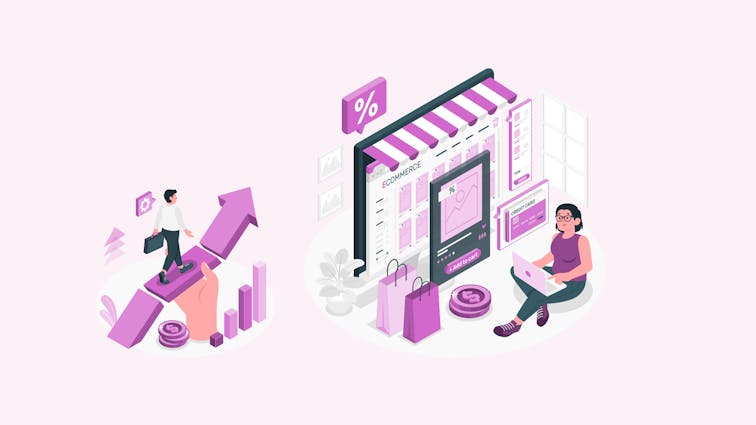
10 Headless Commerce Myths that You Should Not Believe
In the rapidly evolving world of e-commerce, the term ”headless commerce” has been making waves, promising a new era of flexibility and customization.
The headless commerce platform market is projected to reach USD 3.9 billion by 2025, with a notable compound Annual growth rate (CAGR) of 22.9%. The market is projected to reach a market share of approximately USD 2.2 billion by 2023.
However, along with the buzz, a cloud of confusion and misconceptions has also formed, leading many businesses astray. The problem lies in the myths surrounding headless commerce.
Misconceptions such as it being too complex for small businesses, only suitable for large enterprises, or that it requires extensive technical expertise, have created a barrier of apprehension.
These myths have left businesses hesitant to adopt this innovative approach, potentially missing out on significant benefits.
But what if we told you that these myths are just that - myths? What if headless commerce could be the key to unlocking unparalleled flexibility and scalability for your business, regardless of its size or technical capabilities?
In this article, we will debunk the most common myths surrounding headless commerce, providing you with a clear understanding and helping you make an informed decision about whether it’s the right solution for your business.
Stay with us as we navigate through the fog of misconceptions and illuminate the true potential of headless commerce.
Understanding Headless Commerce

But what exactly is headless commerce? Let’s delve into it. Headless commerce is a separation of the front-end and back-end of an e-commerce application.
This decoupling allows the two to operate independently of each other, enabling changes to be made to one without affecting the other.
In a traditional e-commerce setup, the front-end and back-end are intertwined.
This means that any changes to the user interface (the front-end) could potentially disrupt the back-end operations (like inventory management, order processing, etc.), and vice versa.
This can limit flexibility and slow down the implementation of updates or changes.
With headless commerce, the front-end, or the “head”, is removed from the back-end.
This allows developers to make changes to the front-end without worrying about disrupting back-end operations.
It also means that marketers can update and change the user interface to create unique, personalized customer experiences without needing to adjust the back-end.
The Role of APIs in Headless Commerce
APIs, or Application Programming Interfaces, play a crucial role in headless commerce. They act as the bridge between the front-end and back-end, allowing them to communicate and share information.
In a headless commerce setup, when a customer interacts with the front-end (for example, by placing an order), the front-end sends a request to the back-end via the API.
The back-end then processes this request (by updating the inventory, processing the order, etc.) and sends a response back to the front-end via the API, which then updates the user interface accordingly (for example, by confirming the order to the customer).
APIs in headless commerce provide the flexibility for businesses to choose any front-end framework that suits their needs, without being restricted by the capabilities of their back-end platform.
This allows for greater customization and flexibility, enabling businesses to create unique, engaging, and optimized customer experiences.
Debunking the Top 10 Myths About Headless Commerce

Myth 1: Headless Commerce is Too Complicated
Contrary to popular belief, headless commerce isn’t overly complex. It simply refers to the decoupling of the front-end presentation layer of a website from the back-end eCommerce functionality.
This separation allows developers to build and modify the front-end without affecting the back-end, and vice versa. It’s like having a car where you can change the body without messing with the engine.
Myth 2: It’s Too Costly
Many believe that headless commerce is an expensive venture. However, the reality is that it can be a cost-effective solution in the long run.
Traditional eCommerce platforms may require costly and time-consuming updates or re-platforming.
With headless commerce, you can make changes to the front-end without disrupting the back-end, saving both time and money. It’s like updating your phone’s software without needing to buy a new phone.
Myth 3: SEO Will Be Negatively Impacted
Some worry that headless commerce could harm their SEO. However, SEO is largely dependent on content, site speed, mobile usability, and user experience - all areas where headless commerce excels.
By improving site speed and user experience, headless commerce can actually enhance your SEO. It’s like renovating your store to make it more attractive and easier to navigate, which draws in more customers.
Myth 4: Only for Heavyweight Brands
There’s a myth that headless commerce is only for large, enterprise-level brands. But in reality, businesses of all sizes can benefit from the flexibility and customization that headless commerce offers.
Whether you’re a small business looking to provide a unique user experience or a large corporation aiming for scalability, headless commerce can be a game-changer.
It’s like a toolbox that can be used to build anything from a tiny birdhouse to a massive skyscraper.
Myth 5: Requires Continuous Developer Engagement
While it’s true that setting up a headless commerce system requires some technical expertise, it doesn’t mean you’ll need a developer on standby 24/7.
Once the system is set up, the front-end can be managed by your marketing team, while the back-end can be handled by your IT team.
It’s like setting up a self-serve buffet - once the food is prepared and laid out, your guests can serve themselves.
Myth 6: Performance Issues Will Arise
Some people fear that headless commerce will lead to performance issues. However, because the front-end and back-end are decoupled in a headless commerce system, issues in one will not affect the other.
This separation can actually lead to improved performance, as developers can optimize each part independently. It’s like having a relay team where each runner can focus on their own part of the race, leading to a better overall time.
Myth 7: Headless Commerce is Unstable
Some people worry that headless commerce is unstable because it’s a relatively new approach.
However, many successful businesses have already adopted headless commerce and have found it to be reliable.
Plus, because the front-end and back-end are separate, issues in one won’t affect the other, leading to overall stability.
It’s like having a boat with separate compartments - if one compartment takes on water, the others remain unaffected, keeping the boat afloat.
Myth 8: For Tech-Savvy Brands Only
While it’s true that implementing headless commerce requires some technical knowledge, it doesn’t mean it’s only for tech-savvy brands.
Many headless commerce platforms offer support and resources to help businesses transition to a headless model.
Plus, the flexibility and customization that headless commerce offers can benefit all types of businesses. It’s like learning to use a new smartphone - there might be a learning curve, but the benefits are worth it.
Myth 9: Replacing Your Current System is Risky
Change can be scary, and some businesses worry that moving to a headless commerce system is risky.
However, the transition can be managed in stages to minimize disruption. And the benefits of headless commerce - like improved user experience, flexibility, and scalability - can outweigh the risks.
It’s like moving to a new house - it might be a bit chaotic at first, but once you’re settled in, you’ll enjoy the benefits of your new space.
Myth 10: Loss of Control Over Customer Interfacing
Some businesses fear that with headless commerce, they’ll lose control over customer interfacing.
But in fact, headless commerce gives businesses more control over the customer experience.
Because the front-end is decoupled from the back-end, businesses can customize the user interface to meet their customers’ needs without being limited by back-end constraints.
It’s like being a chef in your own kitchen - you have the freedom to create the dishes your customers want, without being limited by a set menu.
Aasaan does Headless commerce the right way!

At Aasaan, our team understands the value and advantage that headless commerce offers without the common myths and misconceptions getting in the way.
We peel back the complexities, giving you the simplicity and flexibility you need. We implement innovative solutions that cater specifically to your business’s needs, big or small - and we do so without breaking the bank.
Our focus is on delivering superior customer experiences, all while maintaining a smooth and intuitive interface for you. Whether you’re in retail, fashion, or groceries, we have the technical prowess to work with a diverse set of businesses.
Using industry-leading tools and best-practices, we balance cost and benefits efficiently. Our results impact not just your business’s growth, but its future redundancies.
At every step of the journey, we ensure that you are never left alone to navigate the various facets and components of headless commerce. Task-shifting and team collaborations form the backbone of our approach hence, making your transition to headless commerce seamless.
It’s like having a trustworthy guide on a hike who knows all the trails - you can confidently move forward knowing you’ve got support.
Remember, headless commerce is not the future, it’s the present. And with Aasaan, your business can be part of this modern initiative, shattering these misleading myths and adopting a more efficient, customer-centric mode of operations.
So, let Aasaan be the one to speed up your transformation. Because, at the end, it is all about wielding headless commerce for your business’s long-term health and growth, in a manner that pleases your clientele, while facilitating easy control on your end.
So come and harness the strengths of headless commerce for your brand - break free from the constraints of traditional systems, step into the world of limitless possibilities, and see how your venture achieves unrivaled success. Think future, think flexibility, think seamless stability; think Aasaan.
FAQ’s:
1. What is headless commerce?
Headless commerce is an approach in e-commerce where the front-end (user interface) and back-end (operations like inventory management, order processing) of an application are separated. This allows them to operate independently, enabling changes to be made to one without affecting the other.
2. How does headless commerce differ from traditional e-commerce setups?
In traditional e-commerce setups, the front-end and back-end are intertwined, meaning changes to one can disrupt the other. In contrast, headless commerce decouples the two, allowing for greater flexibility and faster implementation of updates or changes.
3. What role do APIs play in headless commerce?
APIs, or Application Programming Interfaces, act as the bridge between the front-end and back-end in headless commerce. They allow the two to communicate and share information, enabling the front-end to send requests to the back-end and receive responses.
4. How does headless commerce benefit businesses?
Headless commerce offers businesses greater flexibility and agility. It allows for changes to the user interface without disrupting back-end operations, enabling businesses to create unique, personalized customer experiences. It also allows for faster implementation of updates or changes.
5. Can any business use headless commerce?
Yes, headless commerce is a scalable solution that can benefit businesses of all sizes. Whether you’re a small business looking to grow or a large brand seeking more flexibility and control, headless commerce can be a great fit.








